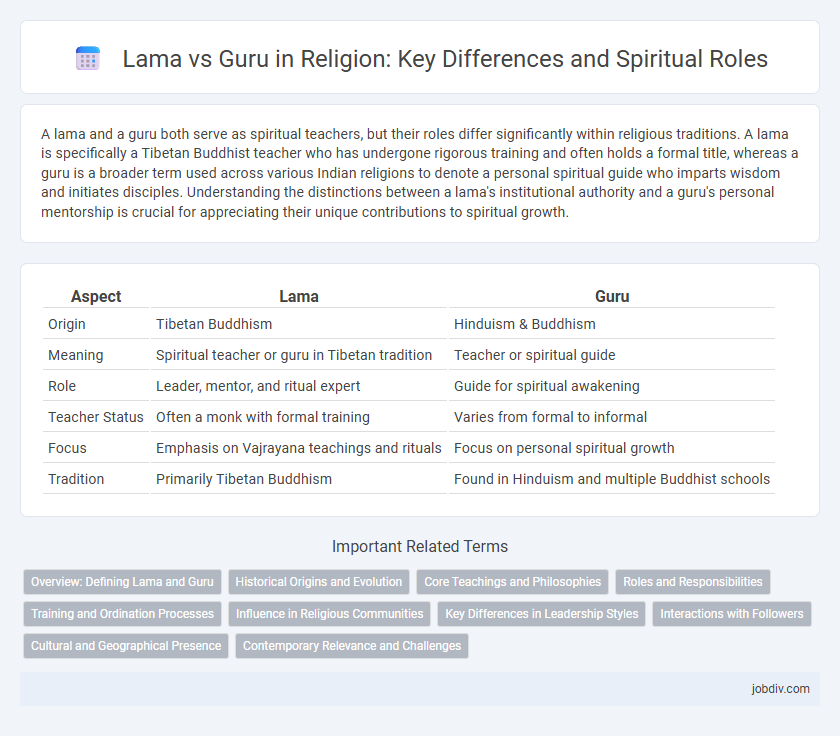A lama and a guru both serve as spiritual teachers, but their roles differ significantly within religious traditions. A lama is specifically a Tibetan Buddhist teacher who has undergone rigorous training and often holds a formal title, whereas a guru is a broader term used across various Indian religions to denote a personal spiritual guide who imparts wisdom and initiates disciples. Understanding the distinctions between a lama's institutional authority and a guru's personal mentorship is crucial for appreciating their unique contributions to spiritual growth.
Table of Comparison
| Aspect | Lama | Guru |
|---|---|---|
| Origin | Tibetan Buddhism | Hinduism & Buddhism |
| Meaning | Spiritual teacher or guru in Tibetan tradition | Teacher or spiritual guide |
| Role | Leader, mentor, and ritual expert | Guide for spiritual awakening |
| Teacher Status | Often a monk with formal training | Varies from formal to informal |
| Focus | Emphasis on Vajrayana teachings and rituals | Focus on personal spiritual growth |
| Tradition | Primarily Tibetan Buddhism | Found in Hinduism and multiple Buddhist schools |
Overview: Defining Lama and Guru
A lama is a Tibetan Buddhist teacher often recognized for their scholarly accomplishment and spiritual guidance within monastic traditions, while a guru in broader Indian spiritual contexts represents a master who imparts wisdom and initiates disciples on a personal level. The term "lama" signifies a title of respect linked to Tibetan Vajrayana Buddhism, emphasizing ritual expertise and lineage transmission. In contrast, the guru embodies a personal mentor role in various Hindu and Buddhist paths, focusing on inner awakening and direct experiential knowledge.
Historical Origins and Evolution
The historical origins of the terms "lama" and "guru" trace back to distinct spiritual traditions, with "lama" rooted in Tibetan Buddhism as a title for revered teachers and spiritual guides, while "guru" originates from ancient Indian Hinduism, denoting a master who imparts wisdom and initiates disciples. Over centuries, the concepts have evolved, with lamas becoming central figures in Vajrayana Buddhism, embodying both ritual authority and lineage transmission. In contrast, gurus in various Indian spiritual paths embody personalized mentorship and enlightenment, influencing modern interpretations across global religions.
Core Teachings and Philosophies
Lama and guru both serve as spiritual teachers in Tibetan Buddhism, yet they emphasize different aspects of guidance. A lama often functions as a formal title acknowledging scholarly achievement and mastery of tantric teachings, whereas a guru embodies a more intimate, experiential transmission of wisdom through devotion and personal relationship. Core teachings stress the lama's role in doctrinal instruction and ritual authority, while the guru focuses on direct realization and transformative spiritual experience.
Roles and Responsibilities
A lama serves as a spiritual teacher and monastic leader in Tibetan Buddhism, responsible for guiding practitioners through rituals, meditation, and ethical conduct. A guru, primarily in Hinduism and Tantra, acts as a personal mentor who imparts secret teachings, initiations, and direct transmission of knowledge to disciples. Both roles emphasize spiritual growth but differ in cultural context and specific duties, with lamas often overseeing community practices and gurus focusing on individualized guidance.
Training and Ordination Processes
Lamas undergo rigorous training in Tibetan Buddhism, including extensive study of sacred texts, meditation practices, and rituals, culminating in formal ordination ceremonies that legitimize their spiritual authority. Gurus in Hindu traditions often receive initiation (diksha) from a senior master, emphasizing personal transmission of knowledge and direct guidance throughout their spiritual development. Ordination for lamas typically involves monastic vows within a monastery, while gurus may not always be formally ordained but are recognized through lineage and disciple acknowledgment.
Influence in Religious Communities
Lamas and gurus hold pivotal roles in shaping religious communities, with lamas often serving as ordained Tibetan Buddhist teachers guiding monastic and lay practitioners through ritual, meditation, and ethical instruction. Gurus, particularly in Hindu and yogic traditions, are revered spiritual leaders who transmit wisdom and initiate disciples into esoteric knowledge, profoundly influencing personal transformation and communal spiritual practices. The authority of both lamas and gurus is rooted in their perceived spiritual attainments, which foster devotion, ethical conduct, and cultural continuity within their respective religious communities.
Key Differences in Leadership Styles
Lamas often adhere to a formal hierarchical leadership style rooted in Tibetan Buddhism, emphasizing ritual authority and monastic tradition, while gurus personally guide disciples through experiential teachings and intimate spiritual mentorship. The lama's role is institutional and community-centered, providing structured guidance within established religious frameworks, whereas the guru's leadership is more individualized, fostering personal transformation through direct, often esoteric, transmission of knowledge. This distinction highlights the lama's focus on collective religious continuity compared to the guru's emphasis on personalized spiritual awakening.
Interactions with Followers
Lamas often emphasize formal teachings and rituals, guiding followers through structured meditations and doctrinal studies, fostering a disciplined spiritual environment. Gurus cultivate personal, intimate relationships, offering individualized guidance that adapts to the unique needs and challenges of each disciple. Both roles deeply influence their communities, but while lamas prioritize institutional continuity, gurus focus on transformative personal mentorship.
Cultural and Geographical Presence
Lamas are primarily associated with Tibetan Buddhism and hold religious authority mainly in Tibet, Bhutan, and parts of Nepal and India, reflecting the Himalayan cultural sphere. Gurus are central to Hinduism and Sikhism, widely venerated across India and Nepal, embodying spiritual guidance within South Asian traditions. The cultural significance of lamas and gurus is deeply intertwined with regional religious practices, shaping diverse spiritual landscapes across Asia.
Contemporary Relevance and Challenges
Lamas and gurus maintain distinct roles in contemporary spiritual practices, with lamas primarily guiding Tibetan Buddhist rituals and gurus often serving broader Hindu and spiritual contexts. The challenge lies in navigating authenticity and commercialization as global interest grows, risking dilution of traditional teachings. Adapting ancient wisdom to modern ethical expectations pressures both figures to balance respect for lineage with contemporary relevance.
lama vs guru Infographic

 jobdiv.com
jobdiv.com